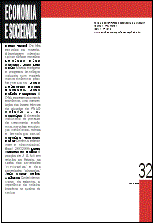Abstract
Este artigo tem por objetivo analisar o processo de crescimento econômico e distribuição funcional da renda em uma situação na qual o progresso tecnológico e a taxa básica de juros são endógenos e a moeda, via oferta de crédito, tem um papel preponderante na determinação da dinâmica de longo prazo da economia. Neste contexto, demonstramos diversas combinações onde ocorrem equilíbrios múltiplos e flutuações amortecidas nas principais variáveis econômicas. Além disso, para baixa parcela salarial, verificamos um predomínio de um regime de acumulação impulsionado pelos lucros e, para altas parcelas, um regime de acumulação impulsionado pelos salários.
Abstract
This article intend to analyze the process of the economic growth and income distribution in an environment where technological progress and the basic rate of interest are endogenous and the money, via credit offer, has a preponderant role in the determination of economic dynamics. In this context, we demonstrate several combinations where happen multiple equilibriums and soften flotation in the main relevant variables. Besides, for low salary portions, we observed the prevalence of a profit-led accumulation regime and, for high portions, a wage-led accumulation regime.
Key words: Non-linear dynamics. Multiple equilibrium. Endogenous money supply. Endogenous technological progress
References
BHADURI, A.; MARGLIN, S. Unemployment and the real wage: the economic basis for contesting political ideologies. Cambridge Journal of Economics, v. 14, n. 4, 1990.
CARVALHO, F. C. Moeda, produção e acumulação: uma perspectiva pós-Keynesiana.,In: MOEDAS e produção: teorias comparadas. Brasília: UnB, 1992.
DE LA FUENTE, A. Mathematical methods and models for economists. Cambridge: Cambridge University Press, 2000.
DUTT, A. K. Stagnation, income distribution and monopoly power. Cambridge Journal of Economics, v. 8, 1984.
________. Accumulation, distribution and inflation in a Marxian/Post keynesian model with a rentier class. Review of Radical Political Economics, v. 21, n. 3, p. 18-26, 1989.
________. Growth, Distribution and uneven Development. Cambridge: Cambridge University Press. 1990 ________. Expectations and equilibrium: implications for Keynes, the neo-Ricardian Keynesians, and the post-Keynesians. Journal of Post Keynesian Economics, v. 14, n. 2, 1992.
________. On the long-run stability of capitalist economies: implications of a model of growth and distribution. In: DUTT, A. K. (Org.). New directions in analytical political economy. Aldershot: Edward Elgar, 1994.
________; AMADEO, E. J. A post-Keynesian theory of growth, interest and money. In: BARANZINI, M.; HARCOURT, G. C. (Ed.). The dynamics of the wealth of nations: growth, distribution and structural change. New York: St. Martins’s Press, 1993.
DOMAR, E. Capital expansion, rate of growth and employment. Econometrica, v. 14, 1946.
EICHNER, A. The megacorp and oligopoly. Cambridge: Cambridge University Press, 1976.
FIOCCA, D. A oferta de moeda na macroeconomia keynesiana. São Paulo: Paz e Terra, 2000.
FREITAS, C. P. Moeda endógena e passividade bancária: uma análise crítica da abordagem “horizontalista” e da Teoria do Circuito Monetário. Revista de Economia Política, v. 19, n. 4, p. 114-133, 1999.
GOODWIN, R. A growth cycle. In: FEINSTEIN, C. H. (Org.). Socialism, capitalism and economic growth. Cambridge: Cambridge University Press, 1967.
GORDON, D.; WEISSKOPF, T.; BOWLES, S. Long-term growth and the cyclical restoration of profitability. In: GOODWIN, R.; KRUGER, M.; VERCCELI, A. (Org.).
Nonlinear models of fluctuating growth. Berlim: Spring-Verlag, 1984.
HARROD, R. An essay in dynamic theory. Economic Journal, v. 49, Mar. 1939.
KALDOR, N. Alternative theories of distribution. Review of Economic Studies, v. 23, n. 2, 1956.
________. A model of economic growth. Economic Journal, v. 67, 1957.
________. The scourge of monetarism. Oxford: Oxford University Press, 1982.
________. How monetarism failed. Challenge, May/Jun. p. 12-21, 1985.
KALECKI, M. The theory of economic dynamics. London: Allen & Unwin, 1954.
________. Selected essays on the dynamics of the capitalist economy. Cambridge University Press, 1971.
KREGEL, J. A. Hamlet without the prince: Cambridge macroeconomics without money. American Economic Review, 1985.
LIMA, G. T. Progresso tecnológico endógeno, crescimento econômico e distribuição de renda. In: LIMA, G. T.; SICSÚ, J.; DE PAULA, L. F. (Org.). Macroeconomia moderna: Keynes e a economia contemporânea. Rio de Janeiro: Campus, 1999.
________; MEIRELLES, A. J. Mark-up bancário, conflito distributivo e utilização da capacidade produtiva: uma macrodinâmica pós-Keynesiana. Revista Brasileira de Economia, Jan./Mar. 2003.
MARX, K. O capital. Rio de Janeiro: Civilização Brasileira, 1971.
MOORE, B. Unpacking the post Keynesian black box: banking lending and the money supply. Journal of Post Keynesian Economics, Summer 1983.
________. Wages, bank lending and endogeneity of credit money. In: JARSULIC, Marc (Org.). Money and macro policy. Hingham: Kluwer Academic Publisher, 1985. p. 1-28.
________. Horizontalists and verticalists: the macroeconomics of credit money. Cambridge: Cambridge University Press, 1988.
NELSON, R.; WINTER, S. An evolutionary theory of economic change. Cambridge: Harvard University Press, 1982.
PASINETTI, L. The rate of profit and income distribution in relation to the rate of economic growth. Review of Economic Studies, v. 29, 1962.
PAULA, L. F. Teoria horizontalista da moeda e do crédito: Crítica da crítica. Estudos Econômicos, São Paulo, v. 33, 2003.
ROBINSON, J. The accumulation of capital. London: MacMillan, 1956.
________. Essays in the theory of economic growth. London: MacMillan, 1962.
ROUSSEAS, S. A mark-up theory of Bank Loan Rates. Journal of Post Keynesian Economics, v. 8, n. 1, 1985.
ROWTHORN, R. Demand, real wages and economic growth. Thames Papers in Political Economy, Autumn 1981.
SCHUMPETER, J. The theory of economic development. 2. ed. New York: Harper & Brothers, 1934.
________. Capitalism, socialism and democracy. New York: Harper & Brothers, 1942.
TAKAYAMA, A. Analytical methods in economics. Michigan: University of Michigan Press, 1993.
VERCELLI, A. Methodological foundations of macroeconomics: Keynes and Lucas. Cambridge: Cambridge University Press, 1991.
WATANABE, K-I. An endogenous growth model with endogenous money supply: integration of post-Keynesian growth models. Banca Nazionale del Lavoro. Quarterly Review, n. 200, Mar. 1997.
A Economia e Sociedade utiliza a licença do Creative Commons (CC), preservando assim, a integridade dos artigos em ambiente de acesso aberto.

